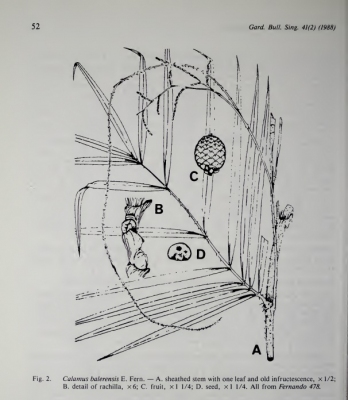Calamus balerensis
Fernando
Arecaceae
Common Name:

Drawings of the plant
Photograph by: The Gardens' Bulletin, Singapore Vol 41 (2) 1988

General Information
Calamus balerensis is a spiny, evergreen, palm growing up to 3 metres tall. It produces a cluster of very slender, unbranched stems around 6mm in diameter with internodes up to 8cm long[
1020- Title
- The Gardens' Bulletin Vol. 41
- Publication
-
- Author
-
- Website
- http://www.biodiversitylibrary.org
- Publisher
- Ministry of National Development, Singapore
- Year
- 1988
- ISBN
- 0374-7859
- Description
- A botanical journal, this issue includes descriptions of four new rattan (calamus) species.
].
The plant is harvested from the wild for its stems, which are used locally for craftwork.
Known Hazards
None known
Botanical References
1020- Title
- The Gardens' Bulletin Vol. 41
- Publication
-
- Author
-
- Website
- http://www.biodiversitylibrary.org
- Publisher
- Ministry of National Development, Singapore
- Year
- 1988
- ISBN
- 0374-7859
- Description
- A botanical journal, this issue includes descriptions of four new rattan (calamus) species.
Range
Southeast Asia - Philippines
Habitat
In forest with large boulders, facing the sea, at elevations around 50 metres[
1020- Title
- The Gardens' Bulletin Vol. 41
- Publication
-
- Author
-
- Website
- http://www.biodiversitylibrary.org
- Publisher
- Ministry of National Development, Singapore
- Year
- 1988
- ISBN
- 0374-7859
- Description
- A botanical journal, this issue includes descriptions of four new rattan (calamus) species.
].
Properties
| Other Uses Rating |      |
| Habit | Evergreen Climber |
| Height | 3.00 m |
| Cultivation Status | Wild |
Cultivation Details
Most species in this genus are more or less vigorous climbing plants in rainforests. Leaves of young plants are normally damaged if exposed to too much light, though leaves of older plants will usually tolerate full sun. In general, plants are likely to grow best with their roots in the shade but with enough gap in the canopy to encourage their stems to grow up towards the light. They are also likely to grow best in a humus-rich soil[
K- Title
- Plants for a Future
- Author
- Ken Fern
- Description
- Notes from observations, tasting etc at Plants For A Future and on field trips.
]. Many of the species require fairly moist conditions for good growth, in fact several of them grow in wet soils or in areas with seasonal inundation - where we have the information it will be included under the plant’s habitat.
Overhead shade should be manipulated at about 6-monthly intervals for the first 2 - 3 years of a young plant’s life to ensure they receive sufficient light to grow vigorously. About 40 - 50% light penetration is generally considered to be ideal for promoting stem growth.
Little care is needed once the seedlings are established. It is important, however, to weed the area surrounding the seedlings occasionally until the plants are more than 2 metres tall.
A dioecious species, both male and female forms need to be grown if fruit and seed are required.
Edible Uses
Although we have no specific information for this species, many members of this genus have potentially edible young shoots. Indeed, in Laos the shoots are considered to be a delicacy and over half the species growing there are said to be cooked and eaten as a vegetable. The top 100cm of the plant is used. If the leaf sheaths are left in place until just before cooking then the shoot will remain fresh for up to one week[
984- Title
- Speciality Rattans of the ASEAN
- Publication
- Blumea 54, pp 39 - 43
- Author
- A. C. Baja-Lapis
- Website
- http://www.ingentaconnect.com/content/nhn/blumea
- Publisher
- National Herbarium, Nederland.
- Year
- 2009
- ISBN
-
- Description
- A description of the uses and agricultural practices for 11 selected species of rattan.
].
Medicinal
None known
Other Uses
The stems are used in handicrafts[
1018- Title
- A Field Guide to Philippine Rattans
- Publication
- Asia Life Sciences Supplement 5
- Author
- Aida C. Baja-Lapis
- Publisher
- Rushing Water Publishers Ltd; Philippines
- Year
- 2010
- ISBN
- 0117-3375
- Description
- A very useful book with concise information on the various rattan species that grow in the Philippines
].
The stems of the closely related Calamus usitatus are of good quality and are used for baskets, furniture and handicrafts[
310- Title
- Plant Resources of Southeast Asia
- Publication
-
- Author
-
- Website
- http://proseanet.org/
- Publisher
-
- Year
- 0
- ISBN
-
- Description
- Lots of information on the uses of the plants of SE Asia.
,
338- Title
- IUCN Red List of Threatened Species
- Publication
-
- Author
-
- Website
- http://www.iucnredlist.org/
- Publisher
-
- Year
- 0
- ISBN
-
- Description
- A list of plants under threat and facing possible extinction, usually with brief details of the threats and information on habitat.
].
Propagation
Seed - it has a fairly short viability and is best sown as soon as it is ripe.
If you have any useful information about this plant, please leave a comment. Comments have to be approved before they are shown here.
 Useful Tropical Plants Database 2014 by
Ken Fern,
web interface by
Ajna Fern
with help from
Richard Morris.
Useful Tropical Plants Database 2014 by
Ken Fern,
web interface by
Ajna Fern
with help from
Richard Morris.